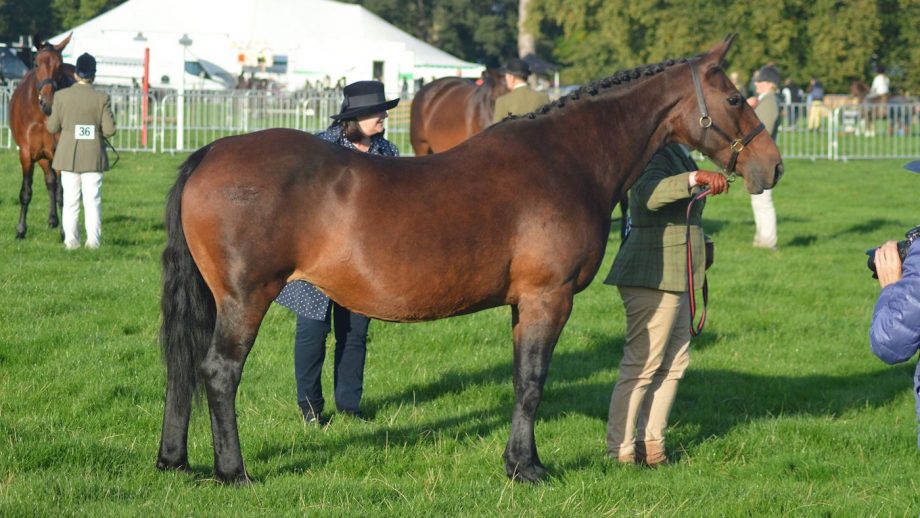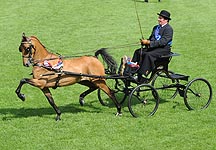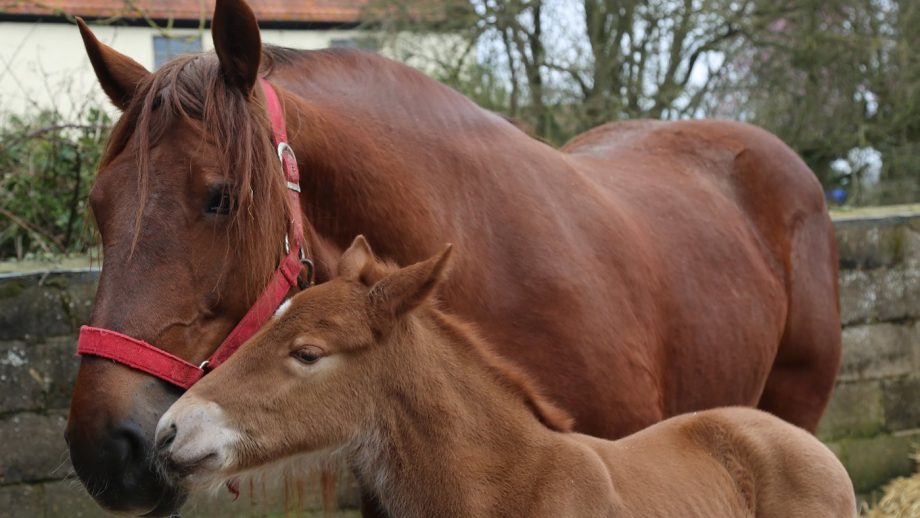Five of Britain’s native breeds are on the Rare Breeds Survival Trust’s critical list, fighting for their survival. Octavia Pollock explains why it’s worth considering these often overlooked horses and ponies...
Anyone who doubts the ability of the Exmoor pony should see the astonishing photograph of Tippbarlake William jumping a hedge out of his field to follow the Beaufort. The wild ponies, with their dark dappled coats and mealy muzzles, are beloved by anyone who devoured Moorland Mousie as a child. Yet the breed is now classed as “endangered” by the Rare Breeds Survival Trust (RBST), as is its southern counterpart, the Dartmoor.
Five other native British breeds are faring even worse: the Cleveland Bay, Eriskay pony, Suffolk, hackney horse and pony and Dales pony are “critical”, with fewer than 300 breeding mares. All five are full of ability and character, yet are often overlooked in favour of more obvious options.
{"content":"PHA+VGhlIG9sZGVzdCBvZiB0aGUgRW5nbGlzaCBicmVlZHMgaXMgdGhlIENsZXZlbGFuZCBCYXksIHdpdGggZW52aWFibGUgdGVtcGVyYW1lbnQgYW5kIHN0YW1pbmEuIFJlY2VudCBnZW5ldGljIHJlc2VhcmNoIHNob3dzIHRoZSBicmVlZOKAmXMgb3JpZ2lucyBnbyBiYWNrIHRvIHRoZSBTYXJtYXRpYW4gdHJpYmVzIG9mIHRoZSBDcmltZWEsIHdobyB0cmF2ZWxsZWQgdG8gdGhlIHJlZ2lvbiBvZiBIYWRyaWFu4oCZcyBXYWxsIGFmdGVyIGEgdHJlYXR5IG9mIDE3NUFEIHdpdGggTWFyY3VzIEF1cmVsaXVzLiBUaGUgc3Ryb25nLCBzd2lmdCBob3JzZXMgd2VyZSBkZXNjcmliZWQgYXMg4oCcYnJvd24gYXMgYXBwbGUgd29vZOKAnSBpbiBCZW93dWxmLCBhYm91dCA3MDBBRCwgYW5kIGV2ZW50dWFsbHkgYmVnYW4gdG8gYmUgdXNlZCBieSBjaGFwbWVuLCBZb3Jrc2hpcmUgdHJhdmVsbGluZyBzYWxlc21lbiwgdG8gY2FycnkgZ29vZHMuPC9wPgo8cD5XaGVuIGNvYWNoZXMgYXJyaXZlZCBpbiB0aGUgcmVpZ24gb2YgRWxpemFiZXRoIEksIENsZXZlbGFuZCBCYXlzLCBuYW1lZCBmb3IgdGhlIFlvcmtzaGlyZSByZWdpb24sIHdlcmUgdGhlIG5hdHVyYWwgY2hvaWNlIHRvIHB1bGwgdGhlbS4gVGhlaXIgZHJpdmluZyBwcm93ZXNzIG5lYXJseSBsZWQgdG8gdGhlaXIgZG93bmZhbGwsIHdpdGggc28gbWFueSBiZWluZyB1c2VkIGluIHRoZSBXb3JsZCBXYXJzIHRoYXQgYnJlZWRpbmcgc3RvY2sgd2FzIGRyYXN0aWNhbGx5IHJlZHVjZWQsIGJ1dCBhbHNvIGxlZCB0byB0aGVpciByZXZpdmFsIHdoZW4gR2VvcmdlIFZJIGFuZCwgbGF0ZXIsIGhpcyBkYXVnaHRlciwgb3VyIFF1ZWVuLCByZWNvZ25pc2VkIHRoZWlyIHZhbHVlLiBOb3csIG5vIFJveWFsIEFzY290IHdlZWsgd291bGQgYmUgY29tcGxldGUgd2l0aG91dCB0aGUgbm9ibGUgYmF5cyB0cm90dGluZyB1cCB0aGUgc3RyYWlnaHQuPC9wPgo8aDM+U3RhbWluYSBhbmQgd2lsbGluZ25lc3M8L2gzPgo8cD5UaGluayBvZiBhIGhhY2tuZXkgYW5kIHlvdSB0aGluayBvZiBhIGNhcnJpYWdlLiBCcmVlZCBkb3llbm5lIEJhcmJhcmEgU3RvY2t0b24gc2hvd2VkIGhpZ2gtc3RlcHBpbmcgaGFja25leXMgZm9yIHNvbWUgMjUgeWVhcnMgYmVmb3JlIHZlbnR1cmluZyBpbnRvIHRoZSBjb2FjaGluZyB3b3JsZCwgY292ZXJpbmcgMzAgbWlsZXMgYSBkYXkgb24gYW5udWFsIHRvdXJzIHdpdGggZm91ci1pbi1oYW5kIHRlYW1zLjwvcD4KPHA+PGRpdiBjbGFzcz0iYWQtY29udGFpbmVyIGFkLWNvbnRhaW5lci0tbW9iaWxlIj48ZGl2IGlkPSJwb3N0LWlubGluZS0yIiBjbGFzcz0iaXBjLWFkdmVydCI+PC9kaXY+PC9kaXY+PHNlY3Rpb24gaWQ9ImVtYmVkX2NvZGUtMzEiIGNsYXNzPSJoaWRkZW4tbWQgaGlkZGVuLWxnIHMtY29udGFpbmVyIHN0aWNreS1hbmNob3IgaGlkZS13aWRnZXQtdGl0bGUgd2lkZ2V0X2VtYmVkX2NvZGUgcHJlbWl1bV9pbmxpbmVfMiI+PHNlY3Rpb24gY2xhc3M9InMtY29udGFpbmVyIGxpc3RpbmctLXNpbmdsZSBsaXN0aW5nLS1zaW5nbGUtc2hhcmV0aHJvdWdoIGltYWdlLWFzcGVjdC1sYW5kc2NhcGUgZGVmYXVsdCBzaGFyZXRocm91Z2gtYWQgc2hhcmV0aHJvdWdoLWFkLWhpZGRlbiI+DQogIDxkaXYgY2xhc3M9InMtY29udGFpbmVyX19pbm5lciI+DQogICAgPHVsPg0KICAgICAgPGxpIGlkPSJuYXRpdmUtY29udGVudC1tb2JpbGUiIGNsYXNzPSJsaXN0aW5nLWl0ZW0iPg0KICAgICAgPC9saT4NCiAgICA8L3VsPg0KICA8L2Rpdj4NCjwvc2VjdGlvbj48L3NlY3Rpb24+PC9wPgo8cD7igJxUaGV5IGhhdmUgc3RhbWluYSBhbmQgd2lsbGluZ25lc3Mg4oCTIGl04oCZcyBoYXJkIHRvIGJlbGlldmUgdGhlIHNpdHVhdGlvbiBpcyBhcyBpdCBpcyzigJ0gc2hlIHNheXMuPC9wPgo8cD5TaGUgcG9pbnRzIG91dCB0aGF0IHRoZXkgaGF2ZSBiZWVuIHRoZSBtb3N0IHN1Y2Nlc3NmdWwgY2FycmlhZ2UgaG9yc2UgaW4gc2hvd2luZzog4oCcSWYgYW5vdGhlciBicmVlZCB3YXMgaGF2aW5nIHRoZSBzdWNjZXNzIHRoZSBoYWNrbmV5IGhhcywgdGhleSB3b3VsZCBiZSBicmVlZGluZyB0aGVtLiBJIGRvbuKAmXQgdW5kZXJzdGFuZCBpdC7igJ08L3A+CjxwPkJhcmJhcmHigJlzIGVtcGxveWVlIERhcnJvbiBMZWEsIHdobyBoYXMgaHVudGVkIHRoZW0sIHNheXM6IOKAnEnigJl2ZSB3b3JrZWQgd2l0aCBob3JzZXMgZnJvbSBicmVha2luZyBpbiBTaGV0bGFuZCBwb25pZXMgdG8gbG9nZ2luZyB3aXRoIFNoaXJlcyBhbmQgeW914oCZZCBzdHJ1Z2dsZSB0byBmaW5kIGEgYmV0dGVyIGhvcnNlIHRoYW4gYSBoYWNrbmV5LjwvcD4KPGRpdiBjbGFzcz0iYWQtY29udGFpbmVyIGFkLWNvbnRhaW5lci0tbW9iaWxlIj48ZGl2IGlkPSJwb3N0LWlubGluZS0zIiBjbGFzcz0iaXBjLWFkdmVydCI+PC9kaXY+PC9kaXY+CjxwPuKAnFlvdSBjYW4gYXNrIGFuZCBhc2sgYW5kIGFzayBhbmQgdGhleeKAmWxsIGdpdmUg4oCTIHlvdSBoYXZlIHRvIGJlIHRoZSBvbmUgdG8gc2F5IHRoZXnigJl2ZSBkb25lIGVub3VnaC7igJ08L3A+CjxwPkhhY2tuZXlzIHN0YXIgaW4gZHJlc3NhZ2UsIHNob3dqdW1waW5nIGFuZCBodW50aW5nLCB0aGVpciBhdGhsZXRpY2lzbSBhbmQgc3RyZW5ndGggaW52YWx1YWJsZSBhdHRyaWJ1dGVzLjwvcD4KPGRpdiBjbGFzcz0iYWQtY29udGFpbmVyIGFkLWNvbnRhaW5lci0tbW9iaWxlIj48ZGl2IGlkPSJwb3N0LWlubGluZS00IiBjbGFzcz0iaXBjLWFkdmVydCI+PC9kaXY+PC9kaXY+CjxwPkNsZXZlbGFuZCBCYXlzLCB0b28sIGV4Y2VsIGJleW9uZCB0aGUgc2hhZnRzLiBNYW55IHdlcmUgZXhwb3J0ZWQgdG8gQW1lcmljYSBpbiB0aGUgbGF0ZSAxOXRoIGNlbnR1cnkgYW5kIGFyZSB2ZXJ5IHBvcHVsYXIgdGhlcmUuIE9yYW5nZSBDb3VudHkgaHVudCBmaWVsZCBtYXN0ZXIgTWFyeWFsaWNlIE1hdGhlc29uLVRob21hcywgd2hvIGhhcyBicmVkIGFuZCB0cmFpbmVkIHRoZW0gZm9yIG5lYXJseSA0MCB5ZWFycywgcHJhaXNlcyB0aGVpciDigJxlYXN5IHRlbXBlcmFtZW50IOKAkyBhbmQgdGhleSBhcmUgc3R1cmR5LCBzb3VuZCBhbmQgYXRobGV0aWPigJ0uPC9wPgo8cD5JbiBFbmdsYW5kLCBCcnVjZSBMYW5nbGV5LU1jS2ltIG9mIFRob3JwZWxleSBJcmlzaCBEcmF1Z2h0IGFuZCBSYXJlIEJyZWVkIFN0dWQgY2hhbXBpb25zIHRoZW06IOKAnENsZXZlbGFuZCBCYXlzIGhhZCBhbiB1bmZhaXIgcmVwdXRhdGlvbiBmb3IgYmVpbmcgYXJyb2dhbnQsIGJ1dCBpdOKAmXMgb25seSB0aGUgd2F5IHRoZXkgd2VyZSBoYW5kbGVkLiBNeSBzdGFsbGlvbnMgd2lsbCBqdW1wIGFueXRoaW5nIEkgcG9pbnQgdGhlbSBhdC7igJ08L3A+CjxkaXYgY2xhc3M9ImFkLWNvbnRhaW5lciBhZC1jb250YWluZXItLW1vYmlsZSI+PGRpdiBpZD0icG9zdC1pbmxpbmUtNSIgY2xhc3M9ImlwYy1hZHZlcnQiPjwvZGl2PjwvZGl2Pgo8cD5TYWRseSwgYSBmYWlsdXJlIHRvIGxpbmsgdGhlIEFtZXJpY2FuIFN0dWQgQm9vayB3aXRoIHRoZSBCcml0aXNoIG1lYW5zIHRoYXQgaW50ZXJuYXRpb25hbCBicmVlZGluZyBtdXN0IGJlIGNhcmVmdWwgbm90IHRvIGRpbHV0ZSB0aGUgZ2VuZXRpY3MuPC9wPgo8aDM+Q29uc2VydmF0aW9uIGdyYXppbmc8L2gzPgo8cD5LZXkgdG8gdGhlIHN1cnZpdmFsIG9mIGFueSByYXJlIGJyZWVkIGlzIHRoYXQgaXQgaGFzIGEgdXNlLCB3aGljaCBpcyBwcm9ibGVtYXRpYyBmb3IgaG9yc2VzLiBBcyBDaHJpc3RvcGhlciBQcmljZSwgY2hpZWYgZXhlY3V0aXZlIG9mIHRoZSBSQlNULCBwb2ludHMgb3V0LCB5b3UgY2FuIHJldml2ZSBjYXR0bGUgb3Igc2hlZXAgYnkgc2VsbGluZyB0aGVpciBwcm9kdWNlLCBidXQgdGhhdCBpcyBzZWxkb20gYW4gb3B0aW9uIGZvciBob3JzZXMuPC9wPgo8cD7igJxTb21lIGNhbiBiZSB1c2VkIGluIGZvcmVzdHJ5LCB3aGVyZSB0aGV5IGNhbiByZWFjaCBwbGFjZXMgbWFjaGluZXMgY2Fu4oCZdCwgYW5kIGZvciBjb25zZXJ2YXRpb24gZ3JhemluZywgYnV0IG90aGVyd2lzZSBpdOKAmXMgbWFpbmx5IHRocm91Z2ggc2hvd2luZywgd2hpY2ggaXMgd2h5IGl04oCZcyBzbyBpbXBvcnRhbnQgdG8ga2VlcCBjbGFzc2VzIGdvaW5nLOKAnSBoZSBzYXlzLjwvcD4KPHA+VW5mb3J0dW5hdGVseSwgY2VydGFpbiBlbnRyZW5jaGVkIGJlbGllZnMgd2l0aGluIHRoZSBzaG93aW5nIHdvcmxkIGhpbmRlciB0aGlzLiBUaGUgZGltaW51dGl2ZSwgdG91Z2ggRXJpc2theSBwb255IG9mIHRoZSBIZWJyaWRlcyBoYXMgYmVlbiBwcm92ZWQgYnkgRE5BIHRlc3RpbmcgdG8gYmUgb25lIG9mIHRoZSBtb3N0IGFuY2llbnQgYW5kIGRpc3RpbmN0IGJyZWVkcyBpbiB0aGUgd29ybGQuIEJ5IHZpcnR1ZSBvZiBpdHMgcmVtb3RlbmVzcywgaXQgZXNjYXBlZCB0aGUgY3Jvc3MtYnJlZWRpbmcgdGhhdCBkaWx1dGVkIHRoZSBzdHJhaW5zIG9mIG90aGVyIGlzbGFuZCBwb25pZXMuPC9wPgo8cD7igJxUaGUgRXJpc2theSBtYWRlIGNyb2Z0aW5nIGxpZmUgaW4gdGhlIFdlc3Rlcm4gSXNsZXMgcG9zc2libGUgZm9yIGdlbmVyYXRpb25zLOKAnSBzYXlzIE5pZ2VsIE1jV2lsbGlhbSBvZiB0aGUgRXJpc2theSBQb255IFNvY2lldHkuIOKAnFRoZXkgd2VyZSBicmVkIGZvciBhIHVuaXF1ZSBzZXQgb2YgY2lyY3Vtc3RhbmNlcyB0aGF0IGdpdmVzIHRoZW0gdGhlaXIgb3duIG5pY2hlIGFzIGRlcGVuZGFibGUgZmFtaWx5IGZyaWVuZHMu4oCdPC9wPgo8cD5Ob3csIHRoZXkgY2FuIGJlIGZvdW5kIGFjcm9zcyB0aGUgVUssIHdpbm5pbmcgZHJpdmluZyBhbmQgVFJFQyB0aXRsZXMgYW5kIGV4Y2VsbGluZyBpbiBzcGhlcmVzIGZyb20gc2hvd2p1bXBpbmcgdG8gZXF1aW5lIHRoZXJhcHkuIEhvd2V2ZXIsIHRoZSBzb2NpZXR5IHdhcyBub3QgZm9ybWVkIHVudGlsIHRoZSAxOTcwcyBhbmQgdGhlcmUgYXJlIHN0aWxsIHRob3NlIHdobyBjb25zaWRlciB0aGVtIG5vdCB0byBiZSBhIGJyZWVkLiBBcyBhIHJlc3VsdCwgdGhleSBhcmUgbm90IGVsaWdpYmxlIGZvciBtb3VudGFpbiBhbmQgbW9vcmxhbmQgY2xhc3NlcyBhdCBOYXRpb25hbCBQb255IFNvY2lldHkgb3IgQnJpdGlzaCBTaG93IFBvbnkgU29jaWV0eSBldmVudHMuPC9wPgo8cD7igJxJdCBpcyBhIGh1Z2UgYmFycmllcizigJ0gbm90ZXMgTmlnZWwuIOKAnEl0IGlzIGtleSB0byB0aGVpciBzdWNjZXNzIHRoYXQgdGhlIHBvbmllcyBhcmUgc2VlbiBvdXQgYW5kIGFib3V0LiBBcGFydCBmcm9tIHRoZWlyIGhpc3RvcmljYWwgYW5kIGdlbmV0aWMgdmFsdWUsIHRoZXkgYXJlIGxvdmVseSBwb25pZXMu4oCdPC9wPgo8cD5PbmUgYnJlZWQgdGhhdCBpcyBleGNlbGxpbmcgaW4gdGhlIHNob3dpbmcgc3BoZXJlIGlzIHRoZSBEYWxlcywgdGhlIHN0cm9uZywgaGFyZHkgYW5kIGxvbmctbGl2ZWQgYmxhY2sgcG9ueSBvZiBZb3Jrc2hpcmUgZmFybWVycywgd2hvIHdvdWxkIGNhcnJ5IGEgbG9hZCwgcHVsbCBhIHRyYXAgYW5kIGdvIGh1bnRpbmcgd2l0aCBlcXVhbCBhcGxvbWIuIFRvcC1xdWFsaXR5IGZvYWxzIGFyZSBpbiBoaWdoIGRlbWFuZCBmb3Igc2hvd2luZywgYnV0IGF0IHRoZSBsb3dlciBlbmQgb2YgdGhlIG1hcmtldCB0aGUgYnJlZWQgaXMgc3VmZmVyaW5nLCB3aXRoIHRyYWRpdGlvbmFsIGNvbG91cmVkIHBvbmllcyBwcm92aW5nIG1vcmUgcG9wdWxhciBhbW9uZyBmYW1pbGllcy48L3A+CjxwPuKAnFRoZXnigJlyZSBub3QgZGVhZCBiZXR3ZWVuIHRoZSBlYXJzLOKAnSBub3RlcyBKaWxsIEdyYWhhbSBvZiB0aGUgRGFsZXMgUG9ueSBTb2NpZXR5LiDigJxZb3UgZG8gaGF2ZSB0byByaWRlIHRoZW0u4oCdPC9wPgo8cD5EYWxlcyBhcmUgd29ydGggY29uc2lkZXJpbmcsIGhvd2V2ZXIsIGJlaW5nIHN1cmVmb290ZWQgYW5kIGludGVsbGlnZW50LjwvcD4KPHA+4oCcVGhleeKAmXJlIG5vdCBuYXR1cmFsIGp1bXBlcnMsIGJ1dCB0aGV5IHdpbGwgaGVhdmUgb3ZlciBhIGRlY2VudCBmZW5jZSBhbmQgbWFrZSBleGNlbGxlbnQgaHVudGVycyzigJ0gc2hlIHNheXMuPC9wPgo8cD5UaGVpciBwcm9ub3VuY2VkIGFjdGlvbiBtYWtlcyB0aGVtIGEgZ29vZCBvcHRpb24gZm9yIGRyZXNzYWdlLCBhbmQgdGhleSBoYXZlIG5vIHVwcGVyIGhlaWdodCBsaW1pdCwgMTVoaCBiZWluZyBhIHVzZWZ1bCBzaXplLjwvcD4KPHA+U29tZSAxMDAgRGFsZXMgZm9hbHMgYXJlIHJlZ2lzdGVyZWQgYSB5ZWFyLCBhbHRob3VnaCBsYXN0IHllYXIgMTI0IHdlcmUgYm9ybi48L3A+CjxwPuKAnEl04oCZcyBhIGNoaWNrZW4tYW5kLWVnZyBzaXR1YXRpb24s4oCdIHNheXMgSmlsbC4g4oCcV2UgZG9u4oCZdCB3YW50IHRvIG92ZXJicmVlZCwgYnV0IGlmIHRoZXJlIGFyZW7igJl0IHBvbmllcyBhdmFpbGFibGUsIGJ1eWVycyB3b27igJl0IGNvbnNpZGVyIHRoZW0u4oCdPC9wPgo8cD5UaGUgZGVtYW5kIHNob3VsZCBiZSB0aGVyZTog4oCcVGhleSB3aWxsIGhhcHBpbHkgdHVybiB0aGVpciBob292ZXMgdG8gYW55dGhpbmcs4oCdIHNheXMgTHluZXR0ZSBNb3JyaXNvbiwgd2hvIGh1bnRzIEFrZWh1cnN0IFRha2UgQSBDaGFuY2Ugd2l0aCB0aGUgUm95YWwgQXJ0aWxsZXJ5IHR3aWNlIGEgd2Vlay4g4oCcSGXigJlzIHRvdWdoIGFzIG9sZCBib290cyBhbmQgc3VyZWZvb3RlZCwgYXMgaGFwcHkgYXQgdGhlIGJhY2sgb2YgdGhlIGZpZWxkIGFzIHVwIGZyb250IG9yIHRyYWlsIGxheWluZy7igJ08L3A+CjxwPlRoZSBwYWlyIGFsc28gZG8gZHJlc3NhZ2UsIHNpZGUtc2FkZGxlLCBldmVudGluZywgVFJFQyBhbmQgaG9yc2ViYWNrIGFyY2hlcnkuPC9wPgo8aDM+QSB1c2UgYmV5b25kIHRoZSB0cmFkaXRpb25hbDwvaDM+CjxwPlRoZSBicm9hZCBjaGVzdG51dCBmbGFua3Mgb2YgdGhlIFN1ZmZvbGssIGNvbGxvcXVpYWxseSB0aGUgU3VmZm9sayBQdW5jaCwgYXJlIGEgZmFtaWxpYXIgc2lnaHQgb24gdGhlIHNob3dncm91bmQgYW5kIGluIHBsb3VnaGluZyBjb21wZXRpdGlvbnMsIGFkb3JuZWQgd2l0aCBnbGVhbWluZyBicmFzc2VzIGFuZCByaWJib25zLiBIb3dldmVyLCBCcnVjZSBpcyBhbW9uZyB0aG9zZSBwcm92aW5nIHRoYXQgdGhleSBoYXZlIGEgdXNlIGJleW9uZCB0aGUgdHJhZGl0aW9uYWwuPC9wPgo8cD7igJxNeSBzdGFsbGlvbiBDcmFpa2hvdyBIYWxsIEplbnNlbiBoYXMgZ29uZSBjbGVhciByb3VuZCDigJhCdXJnaGxleeKAmSDigJMgUG9ueSBDbHViIDgwY20sIGJ1dCBzdGlsbCDigJMgYW5kIGp1bXBzIGhlZGdlcyB3aXRoIHRoZSBDb3R0ZXNtb3JlIGFuZCBGZXJuaWUs4oCdIGhlIG5vdGVzLiDigJxJIGRvbuKAmXQgd2FudCB0byBjaGFuZ2UgdGhlaXIgdHlwZSBvciByZWZpbmUgdGhlbSwgSSB3YW50IGhlaWdodCwgZGVwdGgsIGZyYW1lLuKAnTwvcD4KPHA+SGUgYWRtaXJlcyB0aGUgZGVkaWNhdGlvbiBvZiB0aGUgc2hvd2luZyBmcmF0ZXJuaXR5LCBidXQgdGhyZWUgdGFibGVzIHdvcnRoIG9mIHRhY2sgcHV0IGhpbSBvZmYgdGhhdCByb3V0ZS4g4oCc4oCYU2hvdyBmaXTigJkgb2Z0ZW4gbWVhbnMgdG9vIGZhdCzigJ0gaGUgc2F5cy4g4oCcSSB3YW50IHRvIHNlZSB0aGVtIGFjdHVhbGx5IGRvaW5nIHNvbWV0aGluZyHigJ08L3A+CjxwPlN1ZmZvbGtzIGhhdmUgYSBnZW51aW5lIHZhbHVlIGZvciBqb2JzIHN1Y2ggYXMgaGF1bGluZyB0aW1iZXIgaW4gY29uc2VydmF0aW9uIGFyZWFzLCBidXQgdGhleSBzaG91bGQgbm90IGJlIHJlc3RyaWN0ZWQgdG8gaGFybmVzcy48L3A+CjxwPkdvb2QgbmV3cyBpbiB0aGUgUkJTVCB3YXRjaGxpc3QgMjAyMOKAkzIwMjEgaXMgdGhhdCB0aGUgQ2xldmVsYW5kIEJheSwgRGFsZXMgYW5kIFN1ZmZvbGsgaGF2ZSBhbGwgc2VlbiBtb3JlIHRoYW4gYSA1JSBpbmNyZWFzZSBpbiBicmVlZGluZyBtYXJlcyAoRXJpc2theXMgaGF2ZSBub3QgY2hhbmdlZCBhbmQgaGFja25leXMgaGF2ZSBkZWNsaW5lZCkuIE91ciBmaXZlIHJhcmVzdCBicmVlZHMgYXJlIG5vdCBhbmFjaHJvbmlzbXMgbGVmdCBvdmVyIGZyb20gZWFybGllciB0aW1lcywgYnV0IHZhbHVhYmxlIGFuZCB2YWx1ZWQgaG9yc2VzIGFuZCBwb25pZXMgd2hvc2UgYWJpbGl0aWVzIGdvIGZhciBiZXlvbmQgdGhlaXIgc3RlcmVvdHlwZXMuIFRoZSBwbG91Z2ggb2YgU3VmZm9sayBhbmQgdGhlIGhpbGwgdHJhY2tzIG9mIFlvcmtzaGlyZSBtYXkgbm8gbG9uZ2VyIG5lZWQgdGhlIG5hdGl2ZSBicmVlZHMgb2Ygb2xkLCBidXQgdGhlaXIgZGVzY2VuZGFudHMgZGVzZXJ2ZSB0byB0aHJpdmUgaW4gdGhlIDIxc3QgY2VudHVyeS48L3A+CjxoMz5Nb29yIHRvIG1lYWw8L2gzPgo8cD5UaGUgRGV2b24gYnJlZWQgcmVjb2duaXNlZCBieSB0aGUgUkJTVCBhcyDigJxlbmRhbmdlcmVk4oCdIGlzIHRoZSBEYXJ0bW9vciwgdGhlIFZpY3RvcmlhbiByZXN1bHQgb2YgY3Jvc3NpbmcgY2h1bmt5IGhpbGwgcG9uaWVzIHdpdGggQXJhYnMgYW5kIGhhY2tuZXlzIHRvIGNyZWF0ZSBwb2xvIHBvbmllcyBhbmQgYWRtaXJlZCBhcyBhZ2lsZSBhbmQgYXR0cmFjdGl2ZSwgZ29vZCBmb3IgcmlkaW5nIGFuZCBkcml2aW5nLiBTdGlsbCBvbiB0aGUgbW9vciwgaG93ZXZlciwgYXJlIHNvbWUgMSwyMDAgRGFydG1vb3IgSGlsbCBQb25pZXMsIG9mIGFzc29ydGVkIGNvbG91cnMgYW5kIHNpemVzLiBJbiBhbiBlbmRlYXZvdXIgdG8gZW5zdXJlIHJlY29nbml0aW9uIG9mIHRoZSBoZXJkcyBhZnRlciBCcmV4aXQsIHRoZSBmaXJzdCBnZW5ldGljIHByb2ZpbGluZyBvZiB0aGUgaGlsbCBwb25pZXMgd2FzIGNhcnJpZWQgb3V0IGFuZCByZXZlYWxlZCB0aGF0IHRoZXkgYXBwZWFyIHRvIGJlIGdlbmV0aWNhbGx5IGRpc3RpbmN0LCBzaGFyaW5nIGdlbmVzIG9ubHkgd2l0aCB0aGUgQ2FybmVkZGF1IHBvbmllcyBvZiBXYWxlcy48L3A+CjxwPkFzIEpvc3MgSGliYnMgb2YgdGhlIERhcnRtb29yIEhpbGwgUG9ueSBBc3NvY2lhdGlvbiBleHBsYWlucywgb25lIG1ldGhvZCBvZiBlbnN1cmluZyB0aGV5IHJldGFpbiBhIHZhbHVlIGlzIGJ5IHNlbGxpbmcgdGhlaXIgbWVhdCB0aHJvdWdoIERhcnRtb29yIENvbnNlcnZhdGlvbiBNZWF0LiDigJxJdCBpcyBsZWFuIHJlZCBtZWF0IGFuZCBjb250YWlucyBvbWVnYS0zLCB1c3VhbGx5IGZvdW5kIGluIGZpc2guIFRoZSBwb25pZXMgYXJlIHVuaXF1ZSzigJ0gc2hlIHNheXMuPC9wPgo8aDM+VGhlIHNjaWVudGlmaWMgc2lkZTwvaDM+CjxwPldoZW4gb25seSBhIHNtYWxsIGJyZWVkaW5nIHBvb2wgZXhpc3RzLCBzY2llbnRpZmljIG1ldGhvZHMgY29tZSB0byB0aGUgZm9yZS4gWXZvbm5lIEV2YW5zLCBjaGFpciBvZiB0aGUgRXJpc2theSBQb255IFNvY2lldHksIGlzIGEgbGVhZGluZyBwcm9wb25lbnQgb2YgYXJ0aWZpY2lhbCBpbnNlbWluYXRpb24gKEFJKSBmb3IgcHJlc2VydmluZyByYXJlIGJyZWVkcywgY29sbGVjdGluZyBzZW1lbiBvZiBxdWFsaXR5IHN0YWxsaW9ucy48L3A+CjxwPuKAnFdlIGFyZSBtaW5kZnVsIHRoYXQgd2UgaGF2ZSBvbGRlciBtYXJlcywgdG9vLCB3aG9zZSBlZ2dzIG5lZWQgcHJlc2VydmluZyzigJ0gc2hlIHNheXMuIOKAnElmIHRoZSBnZW5lIHBvb2wgZ2V0cyB0b28gbmFycm93LCBpdCBjYW4gdGlwIG92ZXIgaW50byBleHRpbmN0aW9uLuKAnTwvcD4KPGRpdiBjbGFzcz0iaW5qZWN0aW9uIj48L2Rpdj4KPHA+WXZvbm5lIGNyZWRpdHMgRHIgQW5kcmV3IERlbGzigJlzIHdvcmsgZm9yIENsZXZlbGFuZCBCYXlzIGFuZCBTdWZmb2xrcyBpbiBhdm9pZGluZyB0aGUgbWl4aW5nIG9mIHJhcmUgYmxvb2RsaW5lcyBhbmQgYSByZWR1Y3Rpb24gb2Yg4oCcbWVhbiBraW5zaGlw4oCdIChyZXRhaW5pbmcgYW5pbWFscyB0aGF0IGFyZSBnZW5ldGljYWxseSBpbXBvcnRhbnQpOiDigJxXZSBhcmUgZm9ydHVuYXRlIHRoYXQgd2UgaGF2ZSBoaXMgU3BhcmtzIHByb2dyYW1tZSwgYSB0cmFmZmljLWxpZ2h0IHN5c3RlbSBmb3IgZGV0ZXJtaW5pbmcgd2hldGhlciBhIG1hdGNoIGlzIGdvb2Qgb3IgYmFkLuKAnTwvcD4KPHA+VGhlcmUgd2lsbCBhbHdheXMgYmUgYSBwbGFjZSBmb3IgdHJhZGl0aW9uYWwgYnJlZWRpbmcsIGJ1dCBldmVyLWltcHJvdmluZyBBSSB3aWxsIGhlbHAuPC9wPgo8cD48ZW0+UmVmIEhvcnNlICZhbXA7IEhvdW5kOyAxNCBNYXkgMjAyMDwvZW0+PC9wPgo8cD4K"}
You may also be interested in…
Credit: Maggie Brown
The mare has had a significant impact on the breed, in the UK and abroad
‘I don’t want them to be any smaller, or lighter-framed – I don’t want to lose what a Suffolk horse
Numbers of the Eriskay pony became very low in the early 1970s with just 20 mares and a single stallion
Footage from Emma Massingale's exciting trip will be aired on the BBC’s The One Show later this year
The President's Ride, involving more than 60 Dales ponies, marked the start of a week of centenary celebrations for the
The future of the hackney horse hangs in the balance with less than 300 breeding mares now registered
Credit: Suffolk Horse Society







